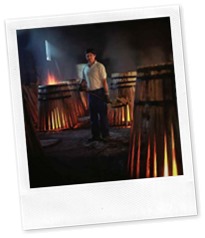Earlier this week, the local Spanish newspaper Diario de Jerez published an article about the sherry casks used in the whisky industry.

What is a sherry cask anyway? In general sherry casks are specially prepared, “seasoned” casks. Nowadays most sherry casks are new barrels made from American oak, which are put together and then sent to a bodega to be filled with (inferior) sherry for a couple of months. The sherry absorbs most of the nasty oak tannins and the cask will be impregnated with the flavours of the wine. It’s a secondary business that has little to do with the actual soleras that hold the authentic sherry wines.

The best example is the neighbouring area Montilla-Moriles which produces the vast majority of Pedro Ximénez wines already. Oban is using Fino casks produced in Montilla for its Oban Distillers Edition. There have been examples of “South-African sherry” matured whiskies as well (Clynelish, Mannochmore among others). Hey Diageo, is it a coincidence that your brands are my best examples? In any case, those are only the ones that openly mention other kinds of sherry (Diageo doesn’t mention ‘sherry’ on the Oban by the way), whereas the real problem are the ones that tell you it’s sherry when technically it’s not. Because you can’t really tell.
Update: Glenfarclas gets its casks from Bodegas José y Miguel Martin, which are located in Huelva – outside of the official sherry region as well.
When you’re using these wines to season casks, can this be called a sherry cask if you’re not allowed to call the wine sherry?
The Consejo Regulador is making plans to get more control on these practices. One of the suggestions is to start a registry of allowed “seasoning companies”. Only these would be allowed to sell proper sherry casks.
In the end it’s a complex matter and I doubt full control is possible. The Consejo Regulador can limit its own producers, but who will control the distilleries? Who is going to track these casks and say whether a certain whisky fully applies to the “sherry matured” regulations? I fear it’s not a priority for the Scotch Whisky Association. Moreover you can probably use a “fake” sherry cask first, and then re-rack into a proper sherry cask. To be continued…